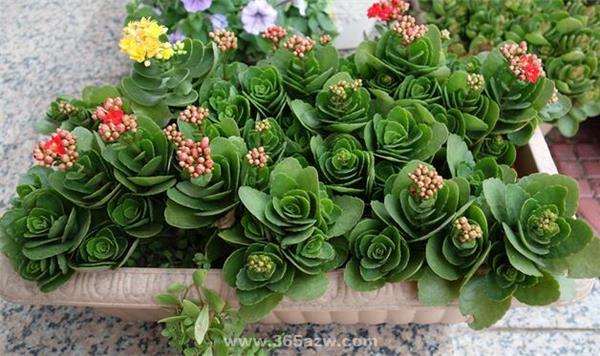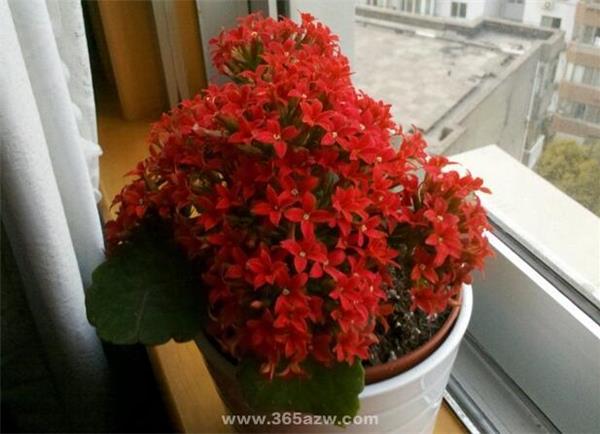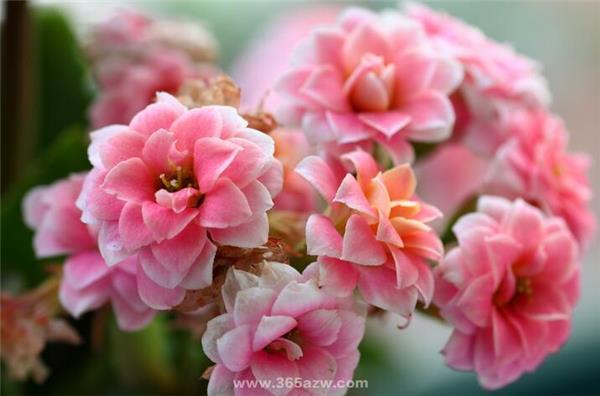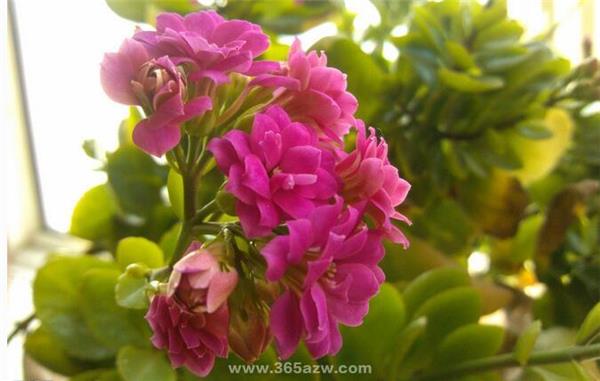Culture methods and matters needing attention of longevity flowers
Longevity flower is a kind of succulent herbaceous plant, which is very popular after flowering. Today, I would like to share with you how to cultivate longevity flowers.
Introduction of longevity flowers:

Christmas cabbage (scientific name: Kalanchoe blossfeldiana Poelln.): also known as longevity flower. Perennial fleshy herbs. The plant height is 10-30 cm. The stem is erect. Leaves simple opposite, elliptic, margin obtusely dentate. Cymes; florets orange-red to crimson. The fruit is fruitful. There are many seeds. The florescence is from February to May.
The leaves are dense and green, blooming near the Christmas festival, clustered into clusters, rich in colors, and are beloved indoor potted flowers. The flower was introduced to Europe from southern Africa by the German R.Blossfeld. But it was not widely cultivated and ornamental in Europe until the 1930s. Up to now, the output value of longevity flowers in the Netherlands, a big flower exporter in the world, reached 333 billion US dollars in 1995, ranking third in potted flower production. In Denmark, potted longevity flowers have become the top pot flowers in Denmark, and their output and output value are in the first place. It shows that longevity flower plays an important role in potted flowers and has become one of the fastest growing potted flowers in the international flower market.
Culture methods of longevity flowers
1. Soil selection for longevity flower culture:
Longevity flowers should not be cultivated in clayey soil, otherwise it will lead to poor growth, rotten roots and leaves, and in serious cases, plant death. The basin soil was mixed with 4 parts of rotten leaf soil, 4 parts of garden soil and 2 parts of river sand, plus a small amount of bone powder. This kind of cultivated soil is loose and fertile, has good drainage performance, and shows a slightly acidic reaction, which is beneficial to the development of root system.

2. Fertilization methods for longevity flower culture:
Longevity flowers should not be cultivated in clayey soil, otherwise it will lead to poor growth, rotten roots and leaves, and in serious cases, plant death. The basin soil was mixed with 4 parts of rotten leaf soil, 4 parts of garden soil and 2 parts of river sand, plus a small amount of bone powder. This kind of cultivated soil is loose and fertile, has good drainage performance, and shows a slightly acidic reaction, which is beneficial to the development of root system.
In the peak growing season, thin compound liquid fertilizer can be applied every 15 to 20 days to promote robust growth and luxuriant flowering. If 0.2% potassium dihydrogen phosphate or 0.5% superphosphate is applied twice after flower bud formation in November, the flowers will be more, the color will be bright, and the florescence will be long.
3. Watering methods for longevity flower culture:
Longevity flowers, like other succulent flowers, contain more water and have a strong ability to resist drought, so they do not need a lot of watering. During the growth period, as long as every 2-3 days to water once, keep the basin soil slightly moist. Watering should be controlled when the temperature is low in winter. If the watering is too much, the drainage is not smooth, and the basin soil is too wet, it is easy to cause root rot.
Although longevity flowers are more drought-tolerant, they can not be short of water in the growing season and can be watered every 2-3 days. In the stage of vegetative growth, the soil must be kept moist and watered at the right time. In summer, longevity flowers can be watered once a day in the environment of high temperature, strong sunshine, large evaporation and dry air. Cold winter, longevity flowers into the dormant period, it should be controlled watering, or even not watered for a short time.

4. Lighting requirements for longevity flower culture:
Longevity flowers like plenty of sunshine, and family training should be placed in places with direct sunlight all the year round. In the northern hot summer season, the light intensity is large, which is easy to make the leaf color yellow, so it is appropriate to shade properly around noon, or put it in the half-shaded part of the room, but pay attention to ventilation and cooling. Long-term cultivation of longevity flowers, if the long-term lack of light, not only slender branches, leaves thin and small, affecting the plant shape beautiful, but also reduce the number of flowers, flowers are not bright, but also cause a large number of leaves to fall off, the loss of ornamental value.
5. Temperature requirements for longevity flower culture:
The most suitable temperature for longevity flower growth is 20-25 ℃. More than 30 ℃ or less than 10 ℃, it obviously stopped growing and entered a dormant or semi-dormant state. In winter, if the temperature is lower than 10 ℃, move into the greenhouse to survive the winter. If there are conditions, the indoor temperature can be controlled at 16: 20 ℃ during the day and 10: 15 ℃ at night, so that longevity flowers can blossom on New year's Day and Spring Festival.
The room temperature in winter should not be lower than 12 ℃. It is better to use 15: 18 ℃ in daytime and more than 10 ℃ at night. If the temperature is as low as 6: 8 ℃, the leaves will turn red and the flowering period will be delayed.
Matters needing attention
Longevity belongs to the cool growth type, which grows fastest in spring and autumn, blossoms in winter and spring, and is basically dormant in summer. So you should reduce watering in summer and put it in a cool and ventilated place to spend the summer.
In addition, in winter, flower friends in the north should pay attention to longevity to avoid the cold, although longevity can sometimes withstand 0 degrees low temperature, but afraid of frost and snow. Therefore, flower friends in the north had better be put in a closed balcony.
About diseases and insect pests
The most common pests of longevity are aphids and shell insects. Prevention and treatment is the key to these two diseases, and the incidence of these two diseases will be much less in a general ventilated environment. In addition, there is another kind of leaf miner larva, which likes to drill into the leaves, and the mesophyll is almost finished by the time it is found. At present, I have not heard of the effective treatment, usually pay more attention to the back of the leaves, it is better to find the eggs as soon as possible. When you find a moth nearby, you can spray insecticidal medicine immediately. In addition, carbofuran can be sprinkled on the surface of the flowerpot, and the plant will poison the worm after absorbing the solution. But please proceed with caution. Huanshen, dimethoate, imidacloprid, paraquat and so on all have effects on these three kinds of diseases and insect pests.

The above is the introduction of the culture methods of longevity flowers, which can be used as a reference.
When you find a moth nearby, you can spray insecticidal medicine immediately. In addition, carbofuran can be sprinkled on the surface of the flowerpot, and the plant will poison the worm after absorbing the solution. But please proceed with caution. Huanshen, dimethoate, imidacloprid, paraquat and so on all have effects on these three kinds of diseases and insect pests.

The above is the introduction of the culture methods of longevity flowers, which can be used as a reference.
Related
- Wuhan Hospital Iron Tree Blooming Result Was Instantly Frightened by the Gardener Master
- Which variety of camellia is the most fragrant and best? Which one do you like best?
- What is the small blue coat, the breeding methods and matters needing attention of the succulent plant
- Dormancy time and maintenance management of succulent plants during dormancy
- Minas succulent how to raise, Minas succulent plant pictures
- What are the varieties of winter succulent plants
- How to raise succulent plants in twelve rolls? let's take a look at some experience of breeding twelve rolls.
- Attention should be paid to water control for succulent plants during dormant period (winter and summer)
- Watering experience of twelve rolls of succulent plants
- Techniques for fertilizing succulent plants. An article will let you know how to fertilize succulent plants.



